OWC Express 4M2
Assembly Manual & User Guide

Introduction
1.1 System Requirements
Operating System
- Mac: macOS 10.12 or later
- PC: Windows 10 or later
Hardware
- Mac or PC with a Thunderbolt 3 port
Supported Drives
- Any PCIe M.2 SSD with 2280 M-Key form factor
- NVMe SSDs with a heatsink are not supported.
1.2 Package Contents
- OWC Express 4M2
- Power supply and cable
- Thunderbolt 3 cable
3 Years of SoftRAID Premium Access (License located on bottom of device)
1.3 Usage Notes
- For best performance, plug this device into a dedicated Thunderbolt 3 host port that is not sharing bandwidth with other devices on neighboring ports.
- Use of the onboard DisplayPort will reduce the bandwidth available to the M.2 SSDs and may impact their performance.
- Does not support Dual-Mode DisplayPort (DP++), however it does support Multi-Stream Transport (MST) in Windows 10.
- All four drive bays are bootable on macOS. SSDs with 512 byte sectors require macOS 10.13 or later
1.4 About This Manual
The images and descriptions may vary slightly between this manual and the unit shipped. Functions and features may change depending on the firmware version. The latest product details and warranty information can be found on the product web page. OWC’s Limited Warranty is not transferable and subject to limitations.
- SSDs with 512 byte sectors require macOS 10.13 or later.
- Macs with Thunderbolt or Thunderbolt 2 ports require the Apple Thunderbolt 3 (USB-C) to Thunderbolt 2 Adapter.
1.5 Front View
A. Power Status LED
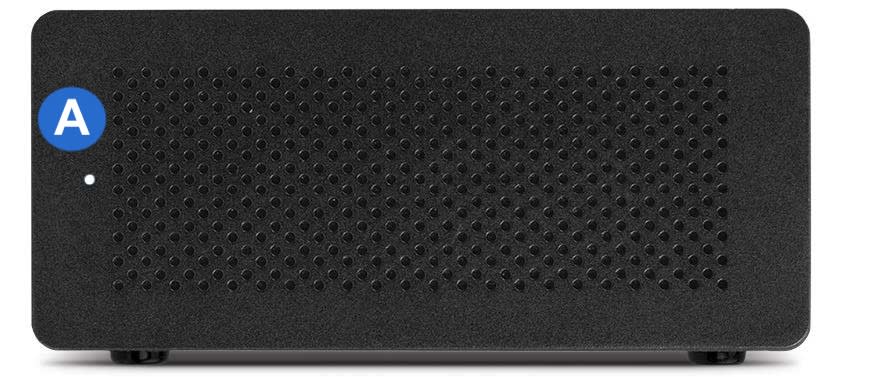
1.6 Rear View
B. (2) OWC ClingOn-ready cable stabilizer mount – Affix ClingOn to help prevent accidental cable disconnections (sold separately)
C. (2) Thunderbolt 3 ports - Attach the included data cable
D. (1) DisplayPort port - Connect a DisplayPort device
E. (1) DC IN power power - Connect the power cable to power the device

Installation
2.1 Assembly
Please follow the instructions below to install one or more M.2 SSDs into the OWC Express 4M2 enclosure. If you have any concerns please contact OWC Support.
1. Remove the Express 4M2 from its packaging then remove the two screws on the back of the device. Safely store the two screws for reassembly.
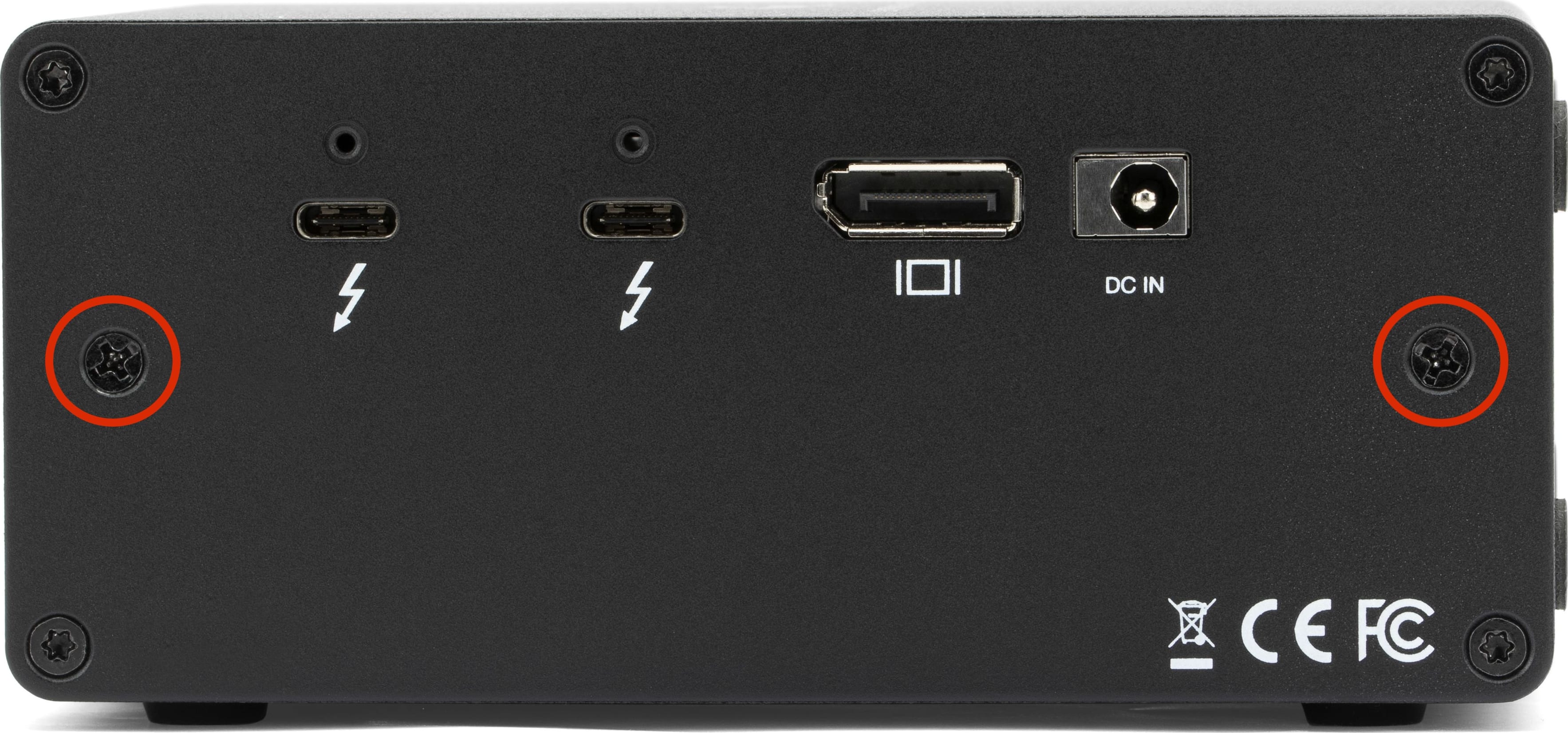
2. Holding the front cover, carefully slide the inner chassis out of the outer enclosure.
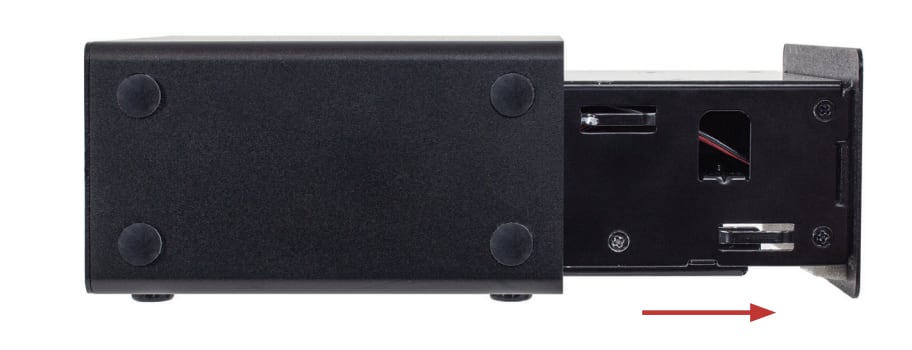
3. Set the outer enclosure aside. Notice there is a fan housing affixed to the inner chassis; this covers the area where SSDs are installed, so it will need to be removed temporarily. Set the inner chassis on your work surface so the fan is facing upward before proceeding to Step 4.
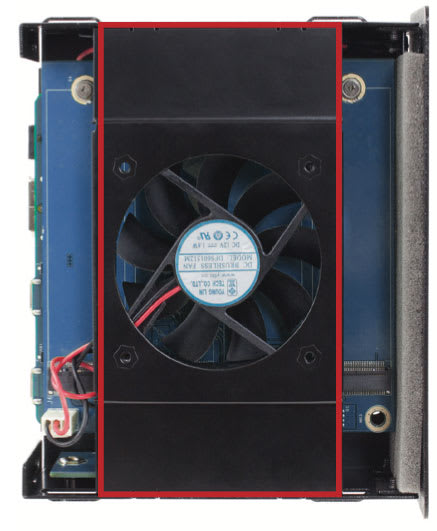
4. Remove the two fan housing screws (one on each side of the inner chassis), then disconnect the fan’s power cable (outlined in yellow) from the circuit board. Set the screws aside then carefully lift the fan housing off the inner chassis and set it aside.

5. The positions of the four M.2 SSD connectors are shown at below in red. NOTE: the four SSD mounting screws are located opposite the connectors, affixed to the circuit board.

6. For each SSD you wish to install, remove the associated mounting screw from the circuit board. Then, align each M.2 SSD with its connector and slide the SSD forward until it is fully seated. If the drive feels stuck, do not force it into the connector; remove it, re-align the SSD’s contacts with the connector and try again.
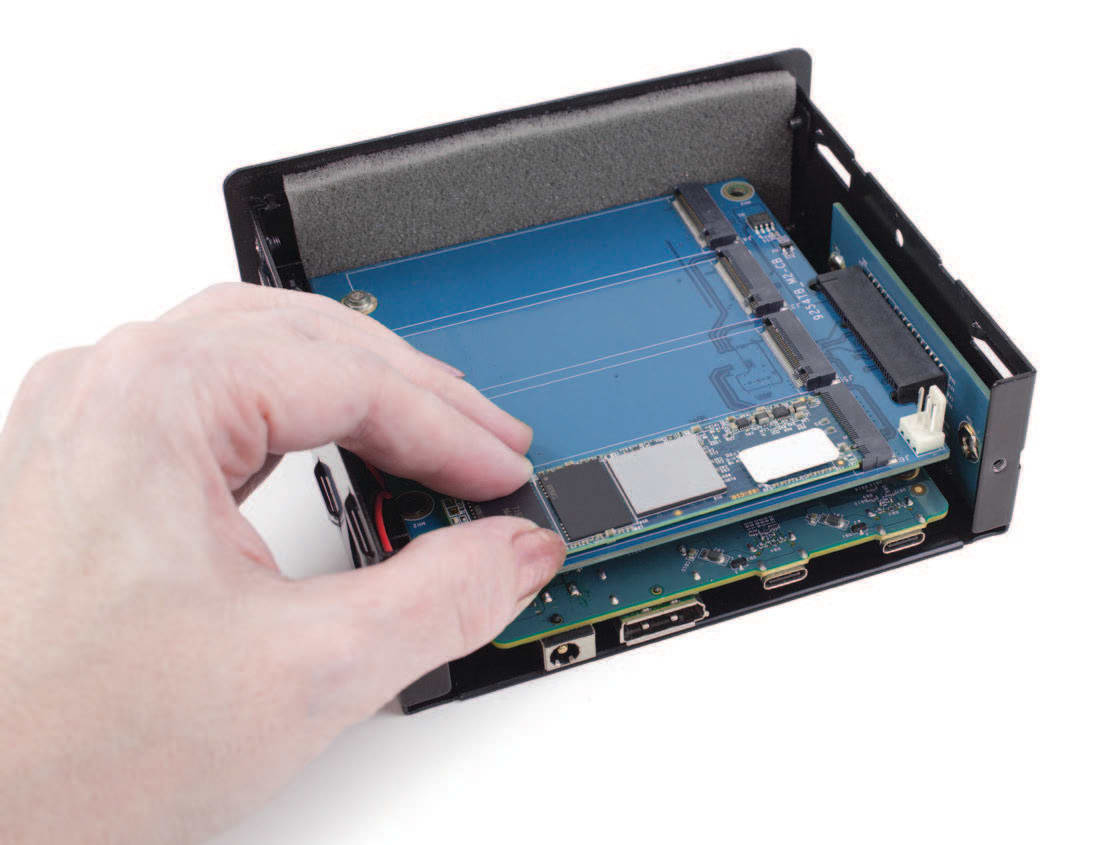
7. Each drive’s mounting screw as shown. Repeat Steps 6 and 7 for each SSD being installed. The image below-left shows what the device looks like with all four M.2 SSDs installed. Note that you can use different brands and capacities of SSD if you wish.
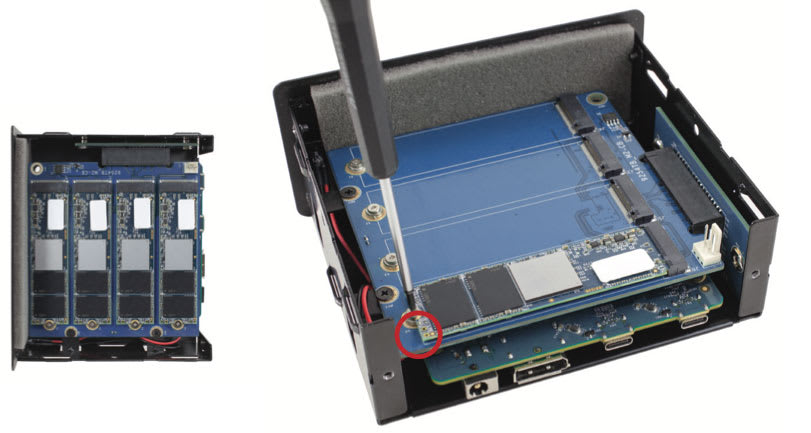
8. Take the fan housing you removed in Step 4 and place it atop the inner chassis again, making sure that the screw holes on the housing align with the screw holes on the inner chassis. Re-affix the two fan housing screws (red arrows), then reseat the power connector (green arrow).
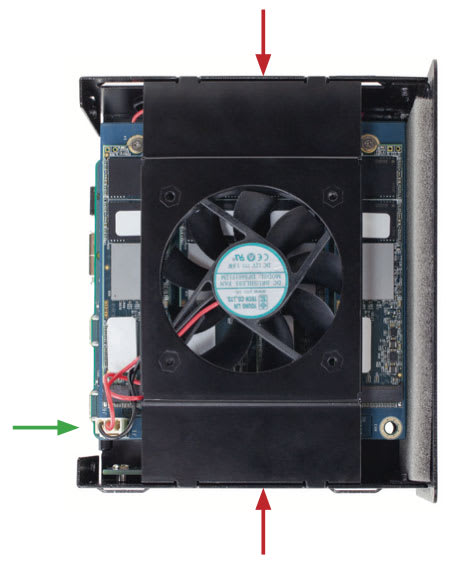
9. Align the inner-chassis with the track in the outer enclosure, then slide the inner chassis into the enclosure. If there is resistance do not force the inner chassis. Remove it, re-align it, then try again.

10. Secure the device using the two removed case screws form earlier. This completes the assembly process. You can now connect the device to power and your host computer with the included cable.

The installed drives are ready to be formatted. Move onto Section 2.2 “RAID Configuration Options” for instructions on how to format and configure the OWC Express 4M2.
2.2 RAID Configuration Options
SoftRAID RAID Configuration
- Downloading and installing the latest version of OWC SoftRAID is recommended to experience the best performance from the OWC Express 4M2.
- NOTE: OWC Express 4M2 devices come bundled with "3 Years of SoftRAID Premium Access". Please visit OWC SoftRAID Product Details for more information regarding SoftRAID and the bundled Premium Access.
- SoftRAID will assist with formatting the installed drives and setting up a RAID volume.
- NOTE: The OWC SoftRAID license is located on the bottom of the OWC Express 4M2.
Mac OWC SoftRAID Setup
- Download OWC SoftRAID for Mac.
- Please review and follow the steps outlined in OWC SoftRAID Installation for Mac.
- Please review and follow the instructions outlined in Creating a macOS OWC SoftRAID Volume.
Windows OWC SoftRAID Setup
- Download OWC SoftRAID for Windows
- Please review and follow the steps outlined in OWC SoftRAID Installation for Windows.
- Please review and follow the instructions outlined in Creating a Windows OWC SoftRAID Volume.
Mac RAID Configurator
- Open the “Disk Utility” application on your Mac.
- Choose “File” and select “RAID Assistant”.
- Select a set type:
- Striped (RAID 0) set: A striped RAID set can speed up access to your data. You can’t create a RAID set on your startup disk; you must first start up your computer from another disk.
- Mirrored (RAID 1) set: Protect your data against hardware failure with a mirrored RAID set. When you create a mirrored RAID set, your data is written to multiple disks so the information is stored redundantly. You can’t create a RAID set on your startup disk; you must first start up your computer from another disk.
- Concatenated (JBOD) set: Increase storage space with a concatenated disk set. If you need one large disk, but you have several smaller disks, you can create a concatenated disk set to use as one large disk.
- Select the checkboxes of the disks you want to include in the set.
- For each disk, click the pop-up menu in the Role column and choose “RAID slice” or “Spare” to designate the disk as a standard member or spare in the set, then click Next.
- Enter a name for the RAID set in the RAID Name field.
- Click the Format pop-up menu, then choose a volume format that you want for all the disks in the set. (See File system formats available in Disk Utility.)
- Click the “Chunk size” pop-up menu, then choose a disk chunk size that you want used for all the disks.
- When you create a striped set, chunks of data from the same file are distributed across the drives. Ideally, you want data distributed across drives evenly and at an optimum size so that it can be efficiently accessed. If you want high data throughput from your set, choose a smaller chunk size so that data is spread across the drives and one drive can be accessing data while another is seeking the next chunk. With mirrored disk sets, choose a chunk size that matches the data you’re accessing. For example, when working with video files, your Mac is accessing large chunks of data, whereas when using a database of many small records, your disks may be accessing smaller chunks of information.
- If you are creating a mirrored RAID set, select the “Automatically rebuild” checkbox to allow the set to be automatically rebuilt when member disks are reconnected
- Click "Create" and then click "Done".
Device Management
3.1 OWC Disk Performance
Windows users connecting the OWC Accelsior SE through an external PCIe enclosure may need to change the default Disk Removal Policy.
- As of Windows 10 v. 1809 the default Disk Removal Policy is ‘Quick removal’ instead of ‘Better performance’.
- NOTE: OWC storage solutions that are experiencing slow read/write speeds should consider checking and changing the Windows disk removal policy. Changing from "Quick removal" to "Better performance" can increase disk performance. OWC offers the application OWC Disk Performance to help change the Disk Removal Policy. Changing from "Quick removal" to "Better performance" can also be changed through OWC SoftRAID or manually through the operating system.
- Please review the support article Storage Solutions: OWC Disk Performance for additional details.
3.2 Manually Unmounting Volumes
To ensure no data is lost during normal use, always eject or unmount the corresponding volume(s) from the operating system before powering off and disconnecting the device. Unmounting options are provided below.
macOS
- Drag the icon for the device you wish to unmount to the trash can; OR
- Right-click the device icon on the desktop, then click “Eject”; OR
- Highlight the device on your Desktop and press Command-E.
Windows
- Windows 10 build 1809 (October 2018) or later:
- Eject the drive by clicking the ‘Show hidden items’ menu in the Taskbar, then clicking ‘Safely Remove Hardware and Eject Media’, and last select the ‘Eject’ option for this volume.
- Windows 10 build 1803 and earlier:
- Go to the System Tray (located in the lower right corner of your screen). Click on the “Eject” icon (a small green arrow over a hardware image).
- A message will appear, detailing the devices that the “Eject” icon controls, i.e., “Safely remove...” Click on this prompt.
- You will then see a message that says, “Safe to Remove Hardware.” It is now safe to disconnect the device from the computer.
Support Resources
4.1 Troubleshooting
- If your computer does not recognize the drive when it is connected, make sure the Thunderbolt 3 cable is attached securely. You can also try plugging the cable into a different Thunderbolt 3 port on your computer and/ or trying a different Thunderbolt 3 cable.
- NVMe SSDs with a heatsink are not supported.
- If you are still having trouble it is possible one or more installed drives were not seated properly. Please use the steps shown in Section 2.1 Assembly to check the drives and make sure they are seated properly. If you continue to have trouble please contact OWC Support for assistance.
4.2 About Data Backup
To ensure your files are protected and to prevent data loss, we strongly suggest that you keep two copies of your data: one copy on your OWC Express 4M2 and a second copy on either your internal drive or another storage medium, such as an optical backup, or on another external storage unit. Any data loss or corruption while using the Express 4M2 is the sole responsibility of the user, and under no circumstances may OWC, its parent, partners, affiliates, officers, employees, or agents be held liable for loss of the use of data including compensation of any kind or recovery of the data.
4.3 Contacting Support
Terms & Conditions of Sale
Changes
The material in this document is for information purposes only and subject to change without notice. While reasonable efforts have been made in the preparation of this document to assure its accuracy, OWC, its parent, partners, affiliates, officers, employees, and agents assume no liability resulting from errors or omissions in this document, or from the use of the information contained herein. OWC reserves the right to make changes or revisions in the product design or the product manual without reservation and without obligation to notify any person of such revisions and changes.
FCC Statement
Warning! Modifications not authorized by the manufacturer may void the user’s authority to operate this device.
NOTE: This equipment has been tested and found to comply with the limits for a Class B digital device, pursuant to Part 15 of the FCC Rules. These limits are designed to provide reasonable protection against harmful interference in a residential installation. This equipment generates, uses and can radiate radio frequency energy and, if not installed and used in accordance with the instructions, may cause harmful interference to radio communications. However, there is no guarantee that interference will not occur in a particular installation. If this equipment does cause harmful interference with radio or television reception, which can be determined by turning the equipment off and on, the user is encouraged to try to correct the interference by one or more of the following measures:
- Reorient or relocate the receiving antenna.
- Increase the separation between the equipment and receiver.
- Connect the equipment to an outlet on a circuit different from that to which the receiver is connected.
Health And Safety Precautions
- Read this guide carefully and follow the correct procedures when setting up the device.
- Use proper anti-static precautions while performing the installation of your drives into this drive enclosure. Failure to do so can cause damage to your drives and/or the enclosure.
- Do not attempt to disassemble or modify the device. To avoid any risk of electrical shock, fire, short-circuiting or dangerous emissions, never insert any metallic object into the device. If it appears to be malfunctioning, please contact OWC Support.
- Never expose your device to rain, or use it near water or in damp or wet conditions. Never place objects containing liquids on the drive, as they may spill into its openings. Doing so increases the risk of electrical shock, short-circuiting, fire or personal injury.
General Use Precautions
- Do not place objects on top of the device.
- To avoid damage, do not expose the device to temperatures outside the range of 5°-40° C (41°-104° F).
- Always unplug the device from the electrical outlet if there is a risk of lightning or if it will be unused for an extended period of time. Otherwise, there is an increased risk of electrical shock, short-circuiting or fire.
- Do not use the device near other electrical appliances such as televisions, radios or speakers. Doing so may cause interference which will adversely affect the operation of the other products.
- Protect your device from excessive exposure to dust during use or storage. Dust can build up inside the device, increasing the risk of damage or malfunction.
- Do not block any ventilation openings on the device. These help to keep the device cool during operation. Blocking the ventilation openings may cause damage to the device and cause an increased risk of short-circuiting or fire.
Warranty
OWC Express 4M2 enclosures have a 1 Year OWC Limited Warranty. For up-to-date product and warranty information, please visit the product web page.
Copyrights and Trademarks
No part of this publication may be reproduced, stored in a retrieval system, or transmitted in any form or by any means, electronic, mechanical, photocopying, recording or otherwise, without the prior written consent of OWC.
© 2020 Other World Computing, Inc. All rights reserved. OWC and the OWC logo are trademarks of New Concepts Development Corporation, registered in the U.S. and/or other countries. Accelsior is a trademark of New Concepts Development Corporation. Mac and macOS are trademarks of Apple Inc., registered in the U.S. and other countries. Other marks may be the trademark or registered trademark property of their owners.
Free Support Chat
Our free award-winning support team is ready to answer all of your questions. Technical support is available Monday - Friday: 9AM - 6PM. Customer Support & Sales is available Monday - Friday: 9AM - 6PM. Support is unavailable on U.S. Federal holidays. Talk to a human today.

 1-800-275-4576
1-800-275-4576